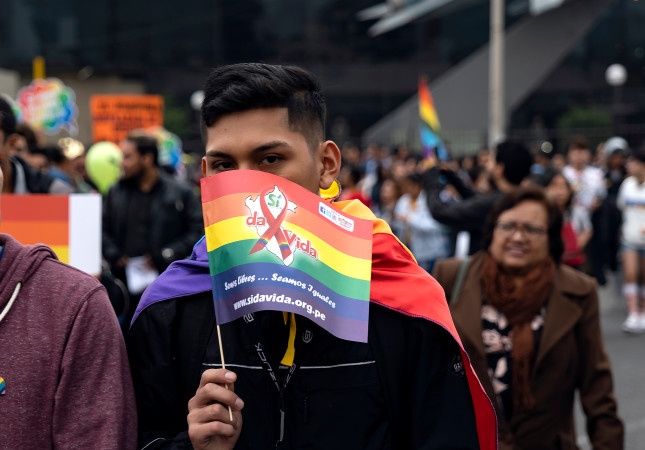-
Most LGBTQ+ Individuals Remain in the “Global Closet”–At Great Cost to Global Health
June 16, 2021 By Sara Matthews
Pride month 2021 is underway, with parades, celebrations, and advocacy movements all over the world. Given the month’s celebratory nature—along with the increasing acceptance of and recent victories for LGBTQ+ * (lesbian, gay, bisexual, transgender, queer or questioning, and others) communities in some countries—it might be easy to assume that most lesbian, gay, and bisexual individuals are “out.” However, according to a study by the Yale School of Public Health, this is far from the case. The vast majority of lesbian, gay, and bisexual individuals remain in the closet, concealing their sexual orientation from “all or most” people in their lives.
The study draws upon data from the European Union lesbian, gay, bisexual, and transgender (EU LGBT) survey, which included 85,000 individuals in 28 countries. The Yale researchers used the data from the question, “To how many people among the following groups are you open about yourself being lesbian/gay/bisexual?” to determine the percentage of participants who are not open about themselves to “all or most other people in their lives.” Based on those findings, the Yale researchers went outside the original sample countries from the EU LGBT survey, taking into account public and government attitudes toward sexual minorities, to estimate the number of closeted individuals worldwide. Based on this analysis, they estimate that 83 percent of lesbian, gay, and bisexual individuals conceal their sexuality from most people in their lives.
Overall, less than half of the countries surveyed had a majority of participants respond that homosexuality should be accepted by society.
Furthermore, there is still a sharp “global divide” in public opinion on and acceptance of homosexuality, according to Pew Research Center. Researchers asked more than 30,000 individuals across 34 countries whether they believe that homosexuality should be accepted by society. Then, they compared their results to previous iterations of the same survey to assess trends over time. They found that acceptance of homosexuality has risen over the past two decades. Ten countries saw a double-digit rise in acceptance since 2002, and, in India, acceptance has risen 22 percentage points since just 2014.
However, levels of acceptance varied widely—from 94 percent in Sweden to 7 percent in Nigeria. Acceptance also varied within countries based on religious beliefs, political ideology, education level, and socioeconomic status. Overall, less than half of the countries surveyed had a majority of participants respond that homosexuality should be accepted by society. While this represents an increase from previous years, it is also a stark reminder that many LGBTQ+ individuals still live in places where their full selves are not embraced or, in some cases, even tolerated.
The issues highlighted by these studies persist to the present day. As of May 2021, 69 countries still have laws criminalizing homosexuality. The COVID-19 pandemic has likely further increased the vulnerability and decreased the visibility of LGBTQ+ communities. Early analyses have found that LGBTQ+ individuals are at higher risk for COVID-19 and more likely to suffer the pandemic’s negative economic effects. However, they have been largely overlooked in COVID-19 responses and data collection efforts.
This invisibility of LGBTQ+ populations creates a significant global health burden, according to the Yale researchers. Concealing one’s sexual orientation is linked to an array of health issues, including depression, anxiety, infectious disease, and premature mortality. Nevertheless, there is a delicate balance between creating visibility and ensuring safety. Concealment causes high levels of individual stress, isolates LGBTQ+ individuals from each other and the broader LGBTQ+ community, and prevents them from receiving adequate public health attention. Nevertheless, in many places, concealment is still safer than the alternative. As long as LGBTQ+ individuals are at risk of violence and discrimination, they won’t feel safe to be “out” and efforts to meet their health needs and integrate them into public health responses will be incomplete.
Read more:
- LGBTQ+ populations face significant barriers to accessing sexual and reproductive health care
- How can stakeholders incorporate inclusivity into their work around bodily autonomy?
- How has COVID-19 impacted adolescents’ sexual and reproductive health and rights?
- How can humanitarian actors rethink data collection to better serve marginalized communities?
*In this piece, we use the term LGBTQ+ because it is the most common acronym used in the United States and the acronym currently being used by the Biden Administration. Other variations include other letters, such as “I” for Intersex, “A” for asexual, and “2S” for two-spirit (a term used by Indigenous communities in North America). In this piece, the “+” is meant to add inclusivity and signify all other gender identities and sexual orientations that are not covered by the five initials in the acronym.
Sources: Bloomberg, European Union Agency for Fundamental Rights, Human Rights Watch, New York Times, PLOS ONE, Pew Research Center, Yale School of Medicine.
Photo Credit: Man hiding behind a rainbow flag marching at the gay pride parade in Lima, Peru. Myriam B/Shutterstock.com, All Rights Reserved.
 A Publication of the Stimson Center.
A Publication of the Stimson Center.



